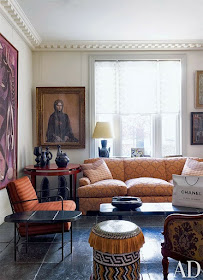I was reading an interesting article talking about the emerging African market and how it is impacting popular culture and the global economy, specifically as it relates to the area of beauty, fashion and home design. Trend watchers attributed it to the younger, more social media savvy kids, the growing affluence of their middle class as well as a designer's ability to showcase collections to an international audience in a global marketplace, and a demand for and love of an ethnic look, juxtaposed into any number of carefully curated interiors. It is being called a trend (again) but it has more significance and staying power than that.
 |
| ph: Giulio Rustichelli via Flair Magazine |
I think the best way to incorporate this look, or any look for that matter, is to take a less is more approach. A few carefully curated pieces make enough of a statement to whisper the aesthetic, not shout it.
 |
| Jacque Grange |
At the NY NOW gift show several manufacturers where displaying tribal art and artifacts ~ each piece seemed to have a story to tell.
 |
| Outpost Original |
 |
| Ngala Trading |
Breathtaking ~
 |
| ph: PersAnders Pettersson |
I myself have incorporated a juju hat or two into a project. Originally from Cameroon, they represent prosperity. I love them for their color, texture and shape.
Beautifully woven baskets reflecting the unique aesthetic of each region is often one of the most lucrative businesses there is in the more remote areas. The weaving techniques passed down for generations.
The Kuba pattern, originally from the Congo, is a highly visible, universally beloved pattern. Its meaning is interpreted as an interuption of the expected line and the shift in form.
Interior designers have incorporated this look for years. Several initiatives and incubators have sprung up to help "fast track" many African fashion designers. Fashion Week in London and NY have seen an insurgence of young talent. It is long overdue.








No comments:
Post a Comment
If you like what you read here at Carrie's Design Musings, consider leaving a comment wouldn't you? XO